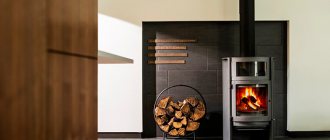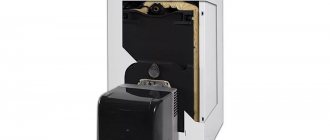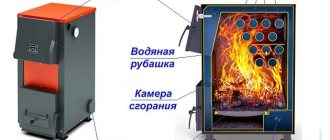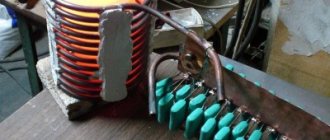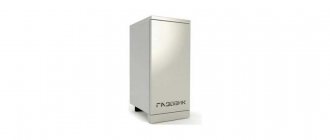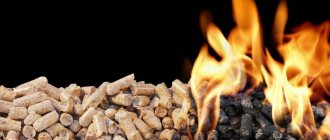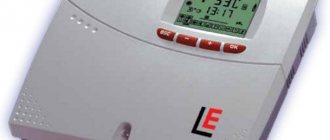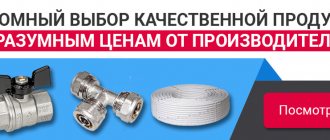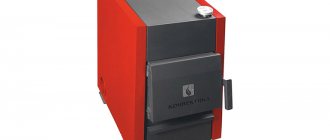Combined heating boilers are increasingly being used to heat country cottages and private houses. – devices that provide optimal temperature regardless of the presence of a centralized gas supply.
Compared to traditional equipment, combined-type units have many advantages, among which the main one is significant savings in money.
However, in order to purchase suitable equipment, you need to carefully familiarize yourself with the selection criteria and assortment.
Rating of the TOP 10 best combined boilers for heating
| Place | Model | Price |
| Models of small and medium thermal power up to 30 kW | ||
| #1 | Teplodar Kupper OVK 18 18 kW | |
| #2 | Teplodar Kupper PRO 28 28 kW | |
| #3 | ACV Delta Pro S 25 26 kW | |
| #4 | Protherm Bizon 30 NL 27.1 kW | |
| #5 | Buderus Logano G125 WS-25 25 kW | |
| High power models from 30 kW | ||
| #1 | Teplodar Kupper PRO 42 42 kW | |
| #2 | Sime 1R6 FREEST 64.8 kW | |
| #3 | Ferroli Atlas Evo 47 | |
| #4 | Sime 1R7 FREEST 74 kW | |
| #5 | Lamborghini Calor EL DB DN EVO 32 | |
Page navigation:
Operating principle of the furnace
The principle of operation of the device with wood and electric heating is based on the ability to turn on the heating elements according to the readings of a thermometer installed in the coolant line. You can describe all the capabilities of the combined device by presenting the algorithm of its operation.
- It is unprofitable to start the system using the electrical part of the furnace. The power of the heater is usually not so great as to completely replace wood-burning stoves, so the kindling is initially done with wood.
- The sensor in the system main detects an increase in temperature and does not connect the heating elements. After the wood burns, as soon as the temperature begins to drop, the electrical circuit automatically closes. The electric heater is capable of maintaining the set temperature for a long time.
- Since the operation of electrical equipment does not require intervention, it is activated at night. Unfortunately, there is no way to regulate the operation of stove equipment when burning wood, but attempts are being made to influence the intensity of the process. Thus, some sensors are equipped with a mechanical drive for the blower valve. As the coolant temperature increases, the door closes and the oxygen supply decreases.
An example of building a heating system for a home
What are combi heating boilers?
For your information! A combined heating boiler is a device designed for heating a room that can operate on solid (wood) or diesel fuel, electricity or gas.
The equipment is universal in use, has a high efficiency and is considered very environmentally friendly .
The device is equipped with everything necessary so that it can be easily connected to a home heating system or to a “warm floor” structure - all additional accessories are usually included in the delivery package.
Extra options
Important details to know:
- boilers must be used for their intended purpose, that is, coal cannot be used in devices intended for burning wood;
- It is better to install a damper near the chimney, although it is used extremely rarely in combination boilers;
- the combustion regulator is not the most significant part, as well as complex automation systems, since the task of adjustment can easily be handled independently using the blower door;
- A water temperature sensor with a thermometer connected to the body must be present, otherwise you may miss the moment of boiling and cause an accident.
How to choose a combi boiler?
In order not to make a mistake in choosing a combined type device for a private home, it is worth familiarizing yourself with its main technical characteristics.
These include:
- maximum thermal power. On average, heating 1 sq.m. area you need to spend 0.1 kW of thermal energy. However, it is better to entrust the calculations to specialists who will help you find the best solution;
- fuel used. The devices are capable of working simultaneously or alternately with several types of fuel. The most popular are electric-gas, electric-wood, gas-wood, as well as models with a wood-diesel fuel combination;
- type of ignition - mechanical or electronic. According to experts, electric ignition is more economical since the unit does not have a pilot light. In addition, in the event of a short-term drop in pressure, the system will automatically resume operation of the boiler;
- heat exchanger material – steel, cast iron or copper. Steel heat exchangers withstand temperature stress well, cast iron ones have a long service life, and copper ones have high efficiency and are less susceptible to high temperatures.
Reviews of universal solid fuel boilers with built-in heating elements: advantages and disadvantages
| Advantages | Flaws |
| Only 10-15% higher cost, which makes the purchase of a combined model more profitable from a financial point of view | Quite simple functionality, lack of advanced automation |
| Partial elimination of the main drawback of TT boilers - the need for constant reloading. According to reviews from owners of even fairly large houses with an area of 150-200 m2, the power of heating elements is enough to maintain a temperature of 17-19°C until the morning. | In universal boilers for wood and electricity, only steel heat exchangers that are susceptible to corrosion are used. There are currently no cast iron models. |
| Saving space in the boiler room | Lower efficiency of heating elements |
| Possibility of using two sources of thermal energy at any time | Typically smaller firebox volume |
| Availability of dual-circuit models | Limited choice of models; foreign manufacturers are almost completely absent from the market |
| Possibility of using electricity for heating only at night at reduced rates (you need an electric meter that differentiates consumption by time zones) | The heating element block has low power and, despite the fact that it can work autonomously, is intended only to maintain temperature, and not to provide full heating |
Popular models
Keep in mind! It is easy to find suitable heating equipment on the domestic market.
The main thing is to decide in advance on the desired parameters and consider the model range in detail.
Models of small and medium thermal power up to 30 kW
TOP-5 rating of models with average power in terms of price and quality ratio.
Teplodar Kupper OVK 18 18 kW
Powerful equipment that is perfect for installation in a small room.
A combined single-circuit unit, presented in a compact housing that will not take up much space in the room.
The presence of a water-tube heat exchanger can significantly improve heat removal and increase the efficiency of the device, which are the main advantages of this model.
Specifications:
- maximum thermal power – 18 kW;
- heat exchanger material – steel;
- fuel – natural gas, coal, firewood, pellets;
- coolant temperature – 60-80 °C;
- control type – mechanical.
Advantages
- steel primary heat exchanger;
- possibility of connecting external control;
- presence of a hob;
- versatility of use;
- Convenient floor installation.
Flaws
- chimney elements will have to be purchased separately;
- lack of draft regulator included;
- complicated operating instructions.
Teplodar Kupper PRO 28 28 kW
An impressive new product, with which you no longer have to think about how to quickly heat the room.
A single-circuit model from the middle price range, which successfully implements a long-burning mode when working on coal and wood.
The device also provides the ability to install a pellet or gas burner - this allows for complete automation of the process, relieving the user of the need to constantly monitor the situation.
Specifications:
- maximum thermal power – 28 kW;
- heat exchanger material – steel;
- fuel – natural gas, coal, coal and wood briquettes, firewood, pellets;
- coolant temperature – 60-95 °C;
- control type – mechanical.
Advantages
- pre-installed thermometer;
- energy independence of equipment;
- long warranty period;
- the presence of a heating element to maintain temperature;
- extended equipment.
Flaws
- weight and dimensions of the structure;
- fast cooling;
- expensive repairs.
ACV Delta Pro S 25 26 kW
A unique model that can pleasantly surprise with its wide functionality and attractive price.
Double-circuit combi boiler designed for floor installation, ideal for both domestic and industrial purposes.
The device is distinguished by the presence of a well-thought-out system of protection against high pressure and overheating, which guarantees absolute safety of operation.
Specifications:
- maximum thermal power – 26 kW;
- heat exchanger material – stainless steel;
- fuel – natural gas, liquefied gas, diesel fuel;
- coolant temperature – 60-90 °C;
- control type – electronic.
Advantages
- power-on indication;
- presence of a thermometer and pressure gauge;
- possibility of connecting external control;
- presence of a safety valve;
- built-in boiler.
Flaws
- the burner is purchased separately;
- high cost of the model;
- It is better to invite a professional for installation.
Protherm Bizon 30 NL 27.1 kW
A highly efficient device that does not require special skills or knowledge to operate.
Single-circuit combined convection type unit, equipped with a thermometer and pressure gauge.
A nice addition was the detailed overheating protection system.
Convenience, reliability, high level of safety - the design has everything for comfortable work.
Specifications:
- maximum thermal power – 27.1 kW;
- heat exchanger material – cast iron;
- fuel – natural gas, liquefied gas, diesel fuel;
- coolant temperature – 30-90 °C;
- control type – electronic.
Advantages
- intuitive control system;
- no need for special maintenance;
- long warranty period;
- high technical characteristics;
- unobtrusive design.
Flaws
- The delivery package does not include an inflatable burner;
- slight noise during operation;
- easily dirty snow-white body.
Buderus Logano G125 WS-25 25 kW
An easy-to-use unit designed for long-term operation without breakdowns.
High-performance heating boiler, in the manufacture of which the most modern technologies were used.
The low-temperature device can be combined with gas and diesel fuel-powered fan burners.
High corrosion resistance is ensured by the use of special gray cast iron.
Specifications:
- maximum thermal power – 25 kW;
- heat exchanger material – cast iron;
- fuel – natural gas, liquefied gas, diesel fuel;
- coolant temperature – 50-90 °C;
- control type – electronic.
Advantages
- large selection of additional equipment;
- water-cooled combustion chamber;
- excellent quality of materials and workmanship;
- reasonable cost;
- good equipment.
Flaws
- no control panel provided;
- device dimensions;
- Questions for the instruction manual.
High power models from 30 kW
The best high-power models according to customer reviews and ratings.
Teplodar Kupper PRO 42 42 kW
The most powerful combined type unit, characterized by ease of maintenance and use.
One of the best-selling models on the domestic market, which has optimal thermal power and a basic mechanical control system.
To maintain the temperature for a long time, the manufacturer has added a high-power heating element to the equipment.
The combustion chamber in the device is open.
Specifications:
- maximum thermal power – 42 kW;
- heat exchanger material – steel;
- fuel – natural gas, coal, coal briquettes, firewood, pellets;
- coolant temperature – 95 °C;
- control type – mechanical.
Advantages
- ease of maintenance;
- sophisticated security system;
- clear instructions included;
- versatility of use;
- acceptable price.
Flaws
- device weight;
- Before installation, you must carefully study the instructions;
- dimensions.
Sime 1R6 FREEST 64.8 kW
A high-tech design that will be the best option for people living in private homes.
A classic heating device with an open combustion chamber, a basic electronic control system and a built-in thermometer.
The unit has high thermal power, so it is perfect for installation in large houses.
Specifications:
- maximum thermal power – 64.8 kW;
- heat exchanger material – cast iron;
- fuel – natural gas, liquefied gas, diesel fuel;
- coolant temperature – 60-90 °C;
- control type – electronic.
Advantages
- simple control system;
- reasonable cost of the device;
- expanded functionality;
- sufficient heated area;
- significant budget savings.
Flaws
- the burner will have to be purchased separately;
- noisy operation of the device;
- specific smell when first used.
Ferroli Atlas Evo 47
A superbly designed device that has absolutely everything for comfortable use.
Highly reliable and energy efficient equipment, presented in a compact case that does not take up much space.
The unit is distinguished by its operation with a low level of sound power, which means that it will definitely not cause any discomfort.
Specifications:
- maximum thermal power – 47 kW;
- heat exchanger material – steel;
- fuel – natural gas, coal, firewood, pellets;
- coolant temperature – 95 °C;
- control type – electronic.
Advantages
- excellent frost protection;
- preset display;
- closed combustion chamber;
- possibility of connecting external control;
- affordable price.
Flaws
- design for everyone;
- rather complicated instruction manual;
- Some items will have to be purchased separately.
Sime 1R7 FREEST 74 kW
A universal floor-standing unit with high technical characteristics.
Standard single-circuit model with an atmospheric combustion chamber, designed for floor installation.
The device can operate with a single-stage burner, but it is also possible to connect a climate regulator.
The warranty period for the device is one year.
Specifications:
- maximum thermal power – 74 kW;
- heat exchanger material – cast iron;
- fuel – natural gas, liquefied gas, diesel fuel;
- coolant temperature – 60-90 °C;
- control type – electronic.
Advantages
- possibility of connecting external control;
- high-quality assembly and excellent materials;
- simple and unobtrusive design;
- almost silent operation;
- clear instruction manual.
Flaws
- The delivery set does not include a burner;
- short warranty period;
- impressive design dimensions.
Lamborghini Calor EL DB DN EVO 32
An ultra-modern device, which is a prominent representative of the economical line.
Floor-mounted combination heating boiler with an ultra-modern design.
The device body is assembled from high-strength cast iron elements with a special arrangement of ribs, which ensures high efficiency and significant energy savings.
Specifications:
- maximum thermal power – 32 kW;
- heat exchanger material – cast iron;
- fuel – diesel fuel, natural and liquefied gas, waste oil, fuel oil;
- coolant temperature – 95 °C;
- control type – electronic.
Advantages
- high performance;
- innovative protection system;
- intuitive control system;
- simplified installation of the structure;
- enhanced thermal insulation.
Flaws
- expensive equipment repairs;
- increased sound power level;
- meager equipment.
The best known manufacturers and models: characteristics and prices
Teplodar Cooper Praktik 14
One of the best wood-electricity combination boilers for heating a private home. Known for its reliability, affordable price, efficiency (thanks to the successful inclined design of the firebox), practicality and ease of cleaning. The boiler also has very compact dimensions. The power of the heating elements is always 6 kW.
The model is the best in terms of price-quality ratio, takes prizes in a variety of ratings, according to installation experience and reviews from owners, there have been no serious service complaints for more than 6 years of operation.
The only drawbacks noted by the owners are the permissible operating pressure of only 1 bar and the gas outlet being too hot, which can cause temperature-unresistant materials, for example, those used in chimneys made of sandwich pipes, to melt or burn.
ZOTA Topol M 14
Another famous combination boiler. It is distinguished by its technology: vertical and horizontal doors for loading fuel, a three-pass heat exchanger, a water jacket cools the ash pan and prevents its deformation, the body is insulated with basalt cardboard, which reduces heat loss through the water jacket. In addition to wood and coal, anthracite can be burned, the maximum pressure is 3 bar, the boiler can be used in a closed heating system.
The main disadvantage is the questionable reliability and build quality. Despite the fact that many boilers have been operating without problems for more than 7 years, there are cases of heat exchanger leakage due to corrosion. Therefore, a prerequisite is the use of purified soft water as a coolant + installation of a softening filter in the system.
Karakan 16TPEV 3
Very compact two-circuit model. It has the simplest design possible, a large loading hole and firebox, is not demanding on fuel and is absolutely omnivorous. The permissible pressure is 3 bar, which allows the boiler to be used in closed systems. The top of the boiler is the cooking surface. There have been no service complaints over more than 5 years of operation.
EVAN WARMOS TT-18
Unpretentious to fuel, but not the most efficient combi boiler. You can burn sawdust, any waste fuel and traditional types of fuel without any problems. It also features a spacious combustion chamber: the burning duration on one load of wood is up to 8 hours, and on coal – up to 15. Despite the simple design, a layer of thermal insulation is provided under the body. There is a standard thermostat that controls the heating element, but the heater power is only 2 kW.
The disadvantages are mediocre quality, reliability and a rather high price for such a simple design.
conclusions
When planning to purchase a combined heating boiler for heating a private home, you must remember that:
- the main criteria for choosing equipment are the maximum thermal power, the type of fuel used and the heat exchanger material;
- Increased attention also to the coolant temperature, control system and design dimensions ;
- For organizing one heating system, a single-circuit device would be a good solution, but if the device is also selected for hot water supply, you should give preference to a dual-circuit model.
What are the benefits of combined installations?
The solution is truly non-standard, and makes it possible to kill several birds with one stone:
- find an alternative to natural gas for heating;
- play it safe for the future by having as many as two additional energy carriers in reserve;
- At the same time, ensure comfortable operation of the heater, eliminating the need to tinker with firewood in the furnace room at night.
Organizing heating with electric wood boilers is also important in new buildings, for the same reasons. At the same time, it is possible to remember old-fashioned methods and install a gravity heating system in order to maximize independence from external influences. Although the convection system is not the best solution in terms of efficiency, it is affordable for installation. And in the event of a power outage, you can always safely switch to firewood.
Installation nuances
The operation of home heating equipment is associated with a significant risk to health and life, therefore manufacturers and regulatory authorities have developed clear rules for its installation, use and maintenance. They are set out in the technical documentation attached to each unit and SNiP (Building Norms and Regulations) standards.
Their strict observance eliminates the possibility of a fire in the home, a gas explosion, and poisoning by combustion products.
Premises requirements
The ideal option for installing the entire complex of equipment is to organize a special room - a boiler room.
This takes into account:
- size of ventilation holes;
- area and volume of the room;
- distance from the protruding parts of the boiler to the walls;
- the presence and size of windows and doors;
- type and power of ventilation;
- presence and nature of electrical wiring and lighting.
If for solid fuel units the presence of a separate room is mandatory, then, for example, for gas-electric boilers with closed combustion chambers, installation in kitchens is allowed. In this case, a coaxial chimney is installed to ensure combustion of gas and removal of its combustion products.
Chimney installation conditions
When purchasing combined heating units, be sure to check that the hole for the chimney matches the dimensions of the chimney pipe. Depending on the model, the gas exhaust hole can be either rectangular or round. If these parameters do not correspond, it will be impossible to install the chimney properly or the installation of additional transition elements will be required.
In cases where the installation of heating equipment requires forced ventilation, you should ensure that the supply duct is larger in area than the chimney duct.
Prices for combined boilers Teplodar
combined boilers Teplodar
Requirements and rules for connecting to the electrical network
In the furnace of small private houses and cottages, electrical equipment is usually installed, consuming from 1 to 5 kW and operating from a single-phase network. In this case, the connection of electric heaters or heating element blocks occurs without significant alteration of the house's power supply system. For more powerful equipment, 380 V power cables are laid.
Lighting in boiler rooms and furnaces should ensure comfortable maintenance of all systems at any time of the day. The SNiP standards in the section “Natural and artificial lighting” discuss in detail the requirements and rules for its technical arrangement.
Criteria for choosing a wood/electricity boiler
When choosing reliable heating equipment, it is not enough to be guided only by the availability of a certain amount of money and personal preferences. The main thing in this complex matter is the technical parameters that ensure the efficiency of the entire system.
When choosing a boiler, be sure to take into account:
- thermal power and area of heated premises;
- type of fuel intended for use;
- possibility of connection to gas mains and electrical networks;
- the presence of special premises for the installation of equipment, equipped with ventilation and a system for removing combustion products;
- type of heating circuit (open or closed);
- the need for coordination with licensing technical authorities.
The ideal option before purchasing any type of heat generator would be to develop a project with an accurate professional calculation of all system parameters. Errors at this stage can lead not only to the fact that the already assembled system will not provide the necessary heat, but also to its complete failure.
Boiler installation
When installing equipment, all the requirements for wood-burning stoves and electric boilers are summed up, and this must be taken into account. First of all, you will have to insulate the surface of the floor and adjacent walls from the effects of temperature. An asbestos slab is installed under the boiler, which simultaneously serves as a flat base and protects the floor covering from fire. Similar measures will have to be taken to protect the wall finishing.
The installation location of the combined device should be dictated by the presence of a water main junction, the installation features of the heating system, and the possibility of installing a chimney pipe.
In order not to load the household network, a separate line should be allocated for electric heating. Such work can only be carried out by representatives of the electrical network service department.
Boiler
Heat exchanger material
Since the thermal efficiency of a heat generator is decisive for the entire heating system, manufacturers use materials with high thermal conductivity to manufacture heat exchangers. Typically this is steel and cast iron for solid fuel installations, and copper and aluminum for gas installations. In modern combined units, especially those with a dual-circuit layout, heat exchangers made of cast iron, steel or non-ferrous metals or their alloys can be used simultaneously.
Prices for Kentatsu combi boilers
Kentatsu combi boilers
